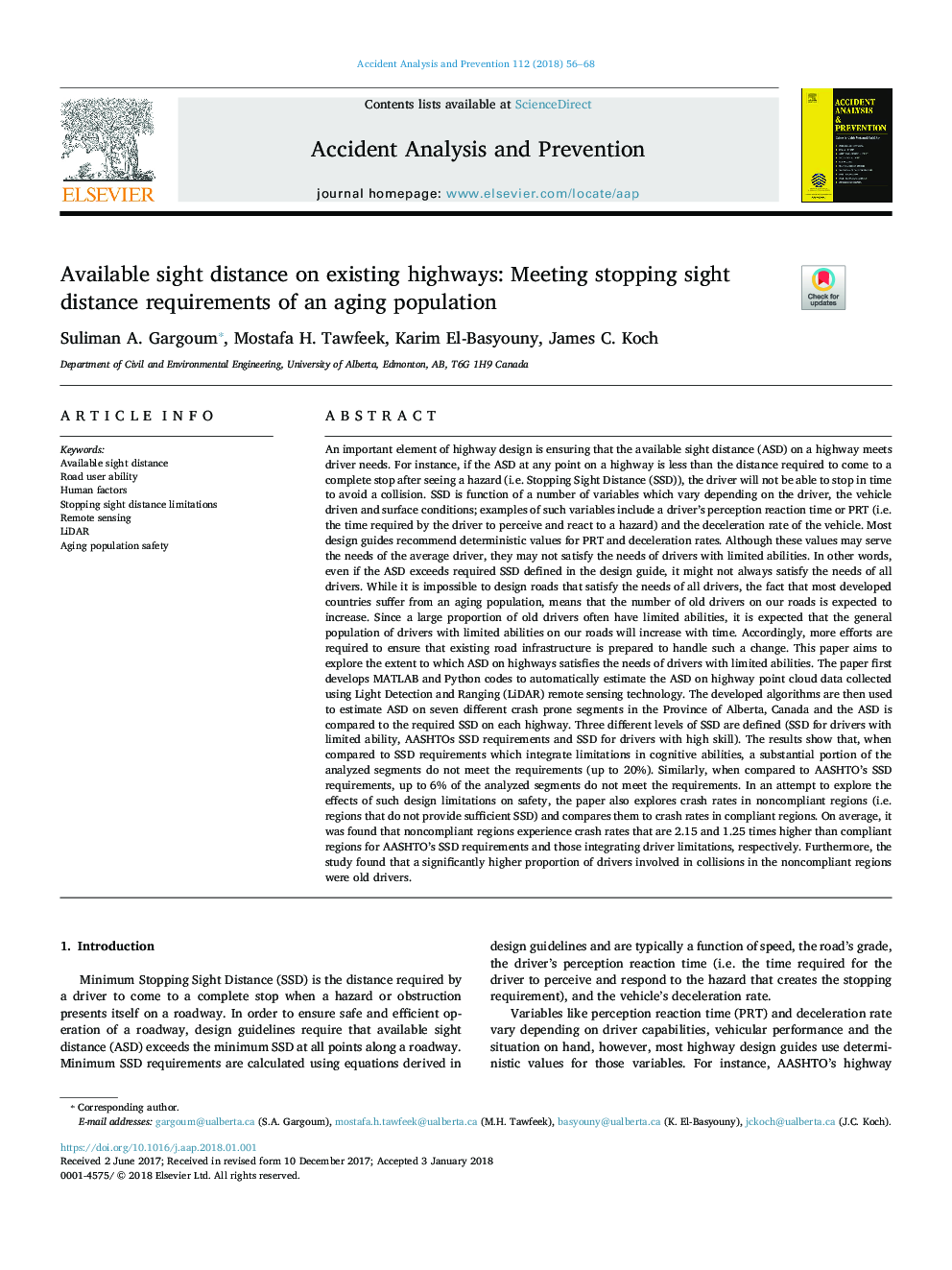| کد مقاله | کد نشریه | سال انتشار | مقاله انگلیسی | نسخه تمام متن |
|---|---|---|---|---|
| 6965233 | 1452887 | 2018 | 13 صفحه PDF | دانلود رایگان |
عنوان انگلیسی مقاله ISI
Available sight distance on existing highways: Meeting stopping sight distance requirements of an aging population
ترجمه فارسی عنوان
فاصله چشم انداز موجود در بزرگراه های موجود: ملاقات برای جلوگیری از نیازهای فاصله بینایی جمعیت پیری
دانلود مقاله + سفارش ترجمه
دانلود مقاله ISI انگلیسی
رایگان برای ایرانیان
موضوعات مرتبط
مهندسی و علوم پایه
مهندسی شیمی
بهداشت و امنیت شیمی
چکیده انگلیسی
An important element of highway design is ensuring that the available sight distance (ASD) on a highway meets driver needs. For instance, if the ASD at any point on a highway is less than the distance required to come to a complete stop after seeing a hazard (i.e. Stopping Sight Distance (SSD)), the driver will not be able to stop in time to avoid a collision. SSD is function of a number of variables which vary depending on the driver, the vehicle driven and surface conditions; examples of such variables include a driver's perception reaction time or PRT (i.e. the time required by the driver to perceive and react to a hazard) and the deceleration rate of the vehicle. Most design guides recommend deterministic values for PRT and deceleration rates. Although these values may serve the needs of the average driver, they may not satisfy the needs of drivers with limited abilities. In other words, even if the ASD exceeds required SSD defined in the design guide, it might not always satisfy the needs of all drivers. While it is impossible to design roads that satisfy the needs of all drivers, the fact that most developed countries suffer from an aging population, means that the number of old drivers on our roads is expected to increase. Since a large proportion of old drivers often have limited abilities, it is expected that the general population of drivers with limited abilities on our roads will increase with time. Accordingly, more efforts are required to ensure that existing road infrastructure is prepared to handle such a change. This paper aims to explore the extent to which ASD on highways satisfies the needs of drivers with limited abilities. The paper first develops MATLAB and Python codes to automatically estimate the ASD on highway point cloud data collected using Light Detection and Ranging (LiDAR) remote sensing technology. The developed algorithms are then used to estimate ASD on seven different crash prone segments in the Province of Alberta, Canada and the ASD is compared to the required SSD on each highway. Three different levels of SSD are defined (SSD for drivers with limited ability, AASHTOs SSD requirements and SSD for drivers with high skill). The results show that, when compared to SSD requirements which integrate limitations in cognitive abilities, a substantial portion of the analyzed segments do not meet the requirements (up to 20%). Similarly, when compared to AASHTO's SSD requirements, up to 6% of the analyzed segments do not meet the requirements. In an attempt to explore the effects of such design limitations on safety, the paper also explores crash rates in noncompliant regions (i.e. regions that do not provide sufficient SSD) and compares them to crash rates in compliant regions. On average, it was found that noncompliant regions experience crash rates that are 2.15 and 1.25 times higher than compliant regions for AASHTO's SSD requirements and those integrating driver limitations, respectively. Furthermore, the study found that a significantly higher proportion of drivers involved in collisions in the noncompliant regions were old drivers.
ناشر
Database: Elsevier - ScienceDirect (ساینس دایرکت)
Journal: Accident Analysis & Prevention - Volume 112, March 2018, Pages 56-68
Journal: Accident Analysis & Prevention - Volume 112, March 2018, Pages 56-68
نویسندگان
Suliman A. Gargoum, Mostafa H. Tawfeek, Karim El-Basyouny, James C. Koch,
